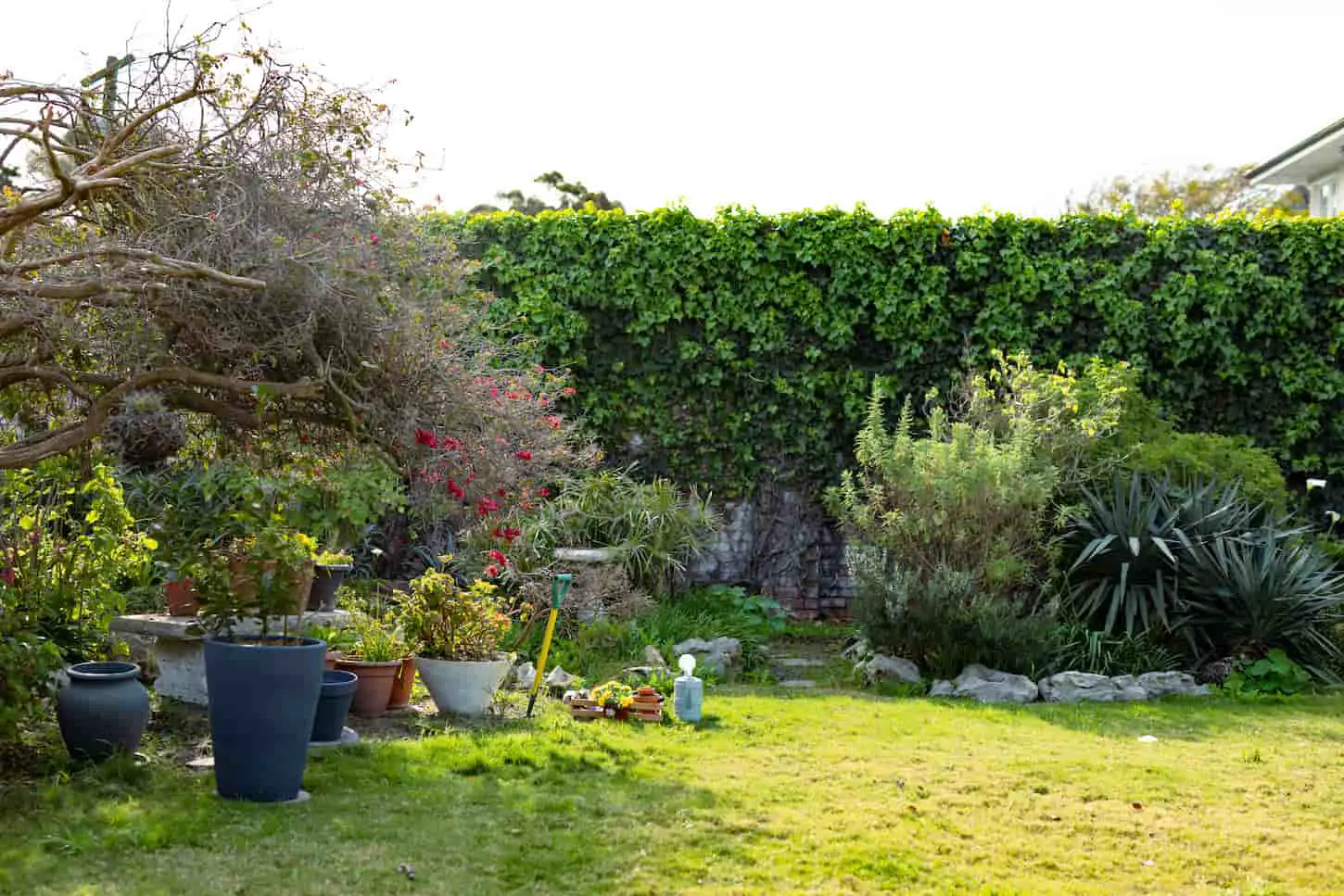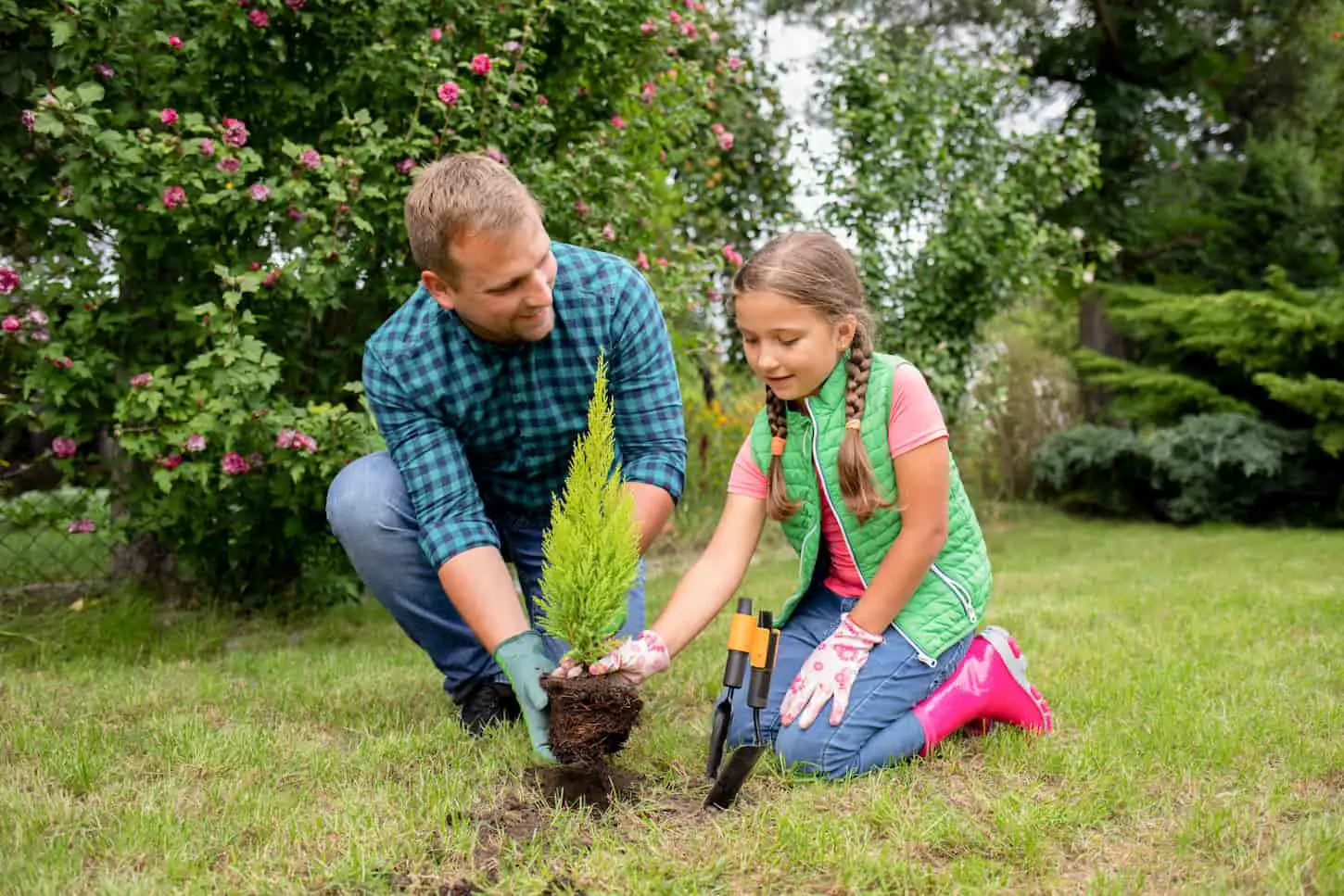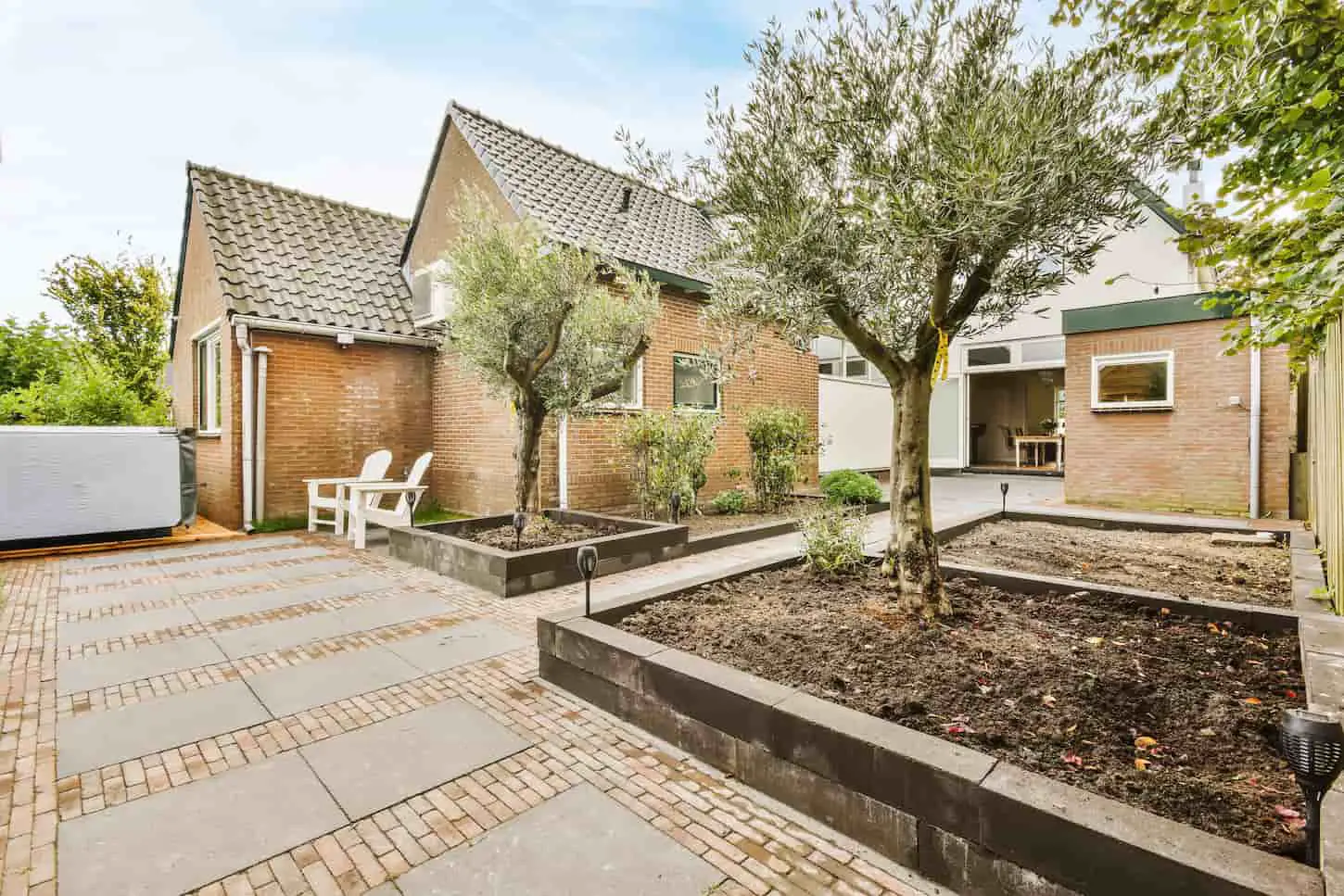Trees make a stunning feature for any home – they provide welcome shade in the summer and can break the cold wind in the winter. If you want to improve your home with trees, you might wonder which ones are the most suitable for the backyard.
The best trees to grow in a backyard depend on the needs, space, and tree requirements. Plant small trees in small backyards or large trees if there is a lot of space. Choose fast-growing evergreen trees for privacy or medium to large deciduous trees for shade.
Planting trees takes some planning and is a long-term commitment, so we must make the right choice. There are hundreds of species to choose from, and we can discover what trees to grow in our backyard below.

The Benefits of Trees in Your Backyard
There are many benefits to planting trees in the backyard. Trees improve the aesthetics of a home and are practical because they offer shade and privacy and reduce noise pollution.
Trees can add value to a home and help keep the house cool in the summer and warm in the winter. In the summer – trees provide vital shade, meaning we won’t need to use fans or air-conditioning as much. In the winter, they act as a windbreaker, which helps to keep the house warm.
Trees improve the appearance of the home and are a fantastic way to create a border around the yard. They encourage wildlife in a garden and provide shady areas for plants or recreation.
Which Tree is Best for the Backyard?
The best tree for a backyard depends on the growing zone and what we want to get from the tree. If we want a privacy barrier – choose fast-growing evergreen trees such as Cypress. For shade around the house – choose large deciduous trees such as Red Maple.
Choosing the best tree for the backyard is essential because it will be there for a long time. If you want trees to thrive, choose native, drought-tolerant, low-maintenance trees suitable for the growing zone.
Avoid invasive trees because they will spread their seeds everywhere and produce saplings around a garden, on the street, and even in the neighbor’s yard. Avoid trees prone to pests and illnesses or delicate trees which break easily.
How to choose the best tree
When we choose a tree for our garden, we must select one according to our climate and grow zone. Consider the function, shape, texture, and height – remember to account for the fact that a tree will grow over time.
Below, we’ll look at the crucial factors to consider when choosing a tree for the backyard.
Factor #1 – Your growing zone and soil type
The first thing to consider when selecting a tree is the growing zone. This zone represents the climate in the state. If we plant a tree in the wrong environment, it won’t thrive, so always choose a tree compatible with your growing zone.
The soil type is also a crucial factor to consider. Some trees, such as Maples, need loose, well-draining sandy earth, while trees like Hawthorn prefer moisture-retaining clay earth. Evaluate the soil before buying a tree and choose one which matches the soil type.
For more about growing trees in clay soil, click here to read our article on doing it right!
Factor #2 – The height
The height is the next thing to consider, and we must account for the tree’s growth. If it’s a small backyard, stick to smaller trees like Crabapple. If we have a tall house and lots of land, we can choose medium to large trees such as Bald Cypress or Red Maple.
Medium and large trees are ideal for shade and perimeter fencing, while small trees make beautiful features in the center of a garden.
Here are the different tree sizes:
- Small trees – Up to 25 Feet
- Medium Trees – Up to 40 Feet
- Large Trees – Can reach over 100 Feet
Factor #3 – The texture
Choose a tree texture according to your needs and preferences. Coarse trees are dense with a striking presence, while fine trees are more subtle.
Here are the different tree textures:
- Coarse – Coarse trees are attention-grabbing, with thick leaves, branches, and dense growth. Coarse trees make the best noise barriers and are better for covering large areas. Avoid coarse trees with spines or thorns because they can be dangerous, especially to pets and small children.
- Medium – Medium textured trees allow airflow and provide adequate shade and screening.
- Fine – Fine trees are small and slender with light foliage and branches. They take up less space and allow more light, so they are ideal for small areas. Fine trees can be messy because they often shed twigs and branches.
Factor #4 – The shape
Trees come in many shapes, and unless you have a large backyard, choose trees with upright growth rather than ones that spread out.
Here’s a list of the different-shaped trees:
- Columnar/Erect – Columnar trees make perfect privacy screens and windbreakers.
- Spreading – Spreading trees are flat-topped, with horizontal branches.
- Open-headed – Open-headed trees don’t have defined outlines and have a loose, open structure.
- Round-headed – Round-headed trees such as the Norway Maple have a round crown, dense branches, and lots of texture.
- Pyramidal – Pyramidal trees like the Spruce are cone-shaped with a main trunk and small branches at right angles.
- Oval – Oval trees such as the Horse Chestnut are egg-shaped and dominant in the landscape.
- Umbrageous – Umbrageous trees such as the disease-resistant elm are excellent for shade and have high branches, so they don’t block the view.
- Weeping – Weeping trees like the Weeping Willow like flat, wet areas. They are very decorative and offer shade and privacy.
If you like the look of weeping trees, ensure you’ve got enough space. In my research, I’ve found that many weeping tree species tend to have expansive root systems that can wreak havoc on sewer lines, so they must be placed carefully.

Where Should I Plant a Tree in My Backyard?
Plant trees around the garden border or in an area for privacy or shade. Planting large trees around the perimeter and smaller ones closer to the house is better. Plant the tree in a place with enough sunlight and room to grow.
To create a sound or privacy barrier – plant trees in a row in the appropriate place. If we want trees for shade around the home in the summer, plant them in the southwest corner 15 to 20 feet from the house.
Don’t plant them directly south because it will be too shady in the winter. If you want a windbreaker for the colder months, plant trees on the north or west side.
Trees need light to thrive, so choose a spot with sufficient sunlight for the tree. Sun-loving trees need at least 6 hours per day, while shade-loving trees only need 2. The area must also have a minimum of 5-6 feet of soil depth.
Can I plant a tree near the house foundation in the backyard?
It is not a good idea to plant a tree near the foundation of a house because as the tree roots grow, they can damage the foundation. The tree roots will hold moisture next to the foundations, which will cause dampness, and the tree may not develop properly if the roots don’t have enough space.
A tree’s root network will spread up to 3 times the size of the tree, so aim to have at least an 18-inch gap between the roots and the foundations when the tree is mature. Plant trees at least 15 feet away from the house or potentially further for a larger tree.
Things to do Before Planting a Tree in the Backyard
Before planting a tree, please talk with a utility provider to make sure you do not put it in a place where it will damage pipes, sewer lines, buried cables, or a septic tank. Ensure the area above the tree is free from obstacles such as overhead cables or power lines.
When planting a tree, it creates a permanent feature on the landscape, so consider the neighbors and community before planting one. Don’t plant trees close to roads or intersections because they might block motorists’ view, and don’t plant large trees too close to a neighbor’s land.
Depending on your area, you may be legally required to call a representative to outline where buried lines, cables, or pipes are before you plant a tree.
In my area, we call “Blue Stakes” before doing any digging – and they come to demarcate everything underground using spray paint. Failure to call first can mean big problems (and a huge financial cost) if and when something goes wrong, thanks to the tree.
Questions to Ask Yourself to Decide Which Tree To Get
There are several questions to ask to help decide which tree to get. For example, do we want an ornamental tree or a functional one? What size tree will suit the backyard, and how much maintenance are we willing to put in?
Let’s take a closer look at some vital questions to ask yourself to help decide which tree to get:
- What are the trees for? If we want functional trees for shade or privacy, we must pick the appropriate ones, such as quick-growing, columnar trees. If we want trees to improve the home’s aesthetics, choose attractive trees that complement the house and garden size.
- Do you want deciduous or evergreen trees? Evergreen trees, such as conifers, have leaves all year round, so they’re ideal for borders and privacy screens. Deciduous trees such as Hawthorns lose their leaves in winter but are perfect for providing summer shade.
- Do you want slow-growing or fast-growing trees? If we’re going to create a barrier quickly, choose fast-growing trees such as the Leyland Cypress. If we’re not in a hurry, we can select slow-growing trees.
- Do you want fruit? If you like producing fruit, choose fruit trees for the backyard. Fruit trees attract nature to a garden, but they can be high maintenance because we’ll need to clean up the fruit (not to mention harvesting).
- Do you enjoy pruning, or do you prefer a low-maintenance garden? Trees such as Eucalyptus need more care and attention than others. If you’re an avid gardener and enjoy maintaining trees, the high-maintenance ones should be no problem.
- If there is no time for gardening, choose a low-maintenance tree such as Blue Spruce.

Frequently Asked Tree Questions
Now that we’ve covered a lot already let’s cover some more frequently asked tree questions. If you don’t see your question, use my contact page to let me know your question. I’ll do my best to answer you directly, and then I’ll update this article so that other people looking for the same answers can find it, too!
Which Trees Need…
Let’s talk about the trees that need the most and least of each particular essential nutrients: sun, water, shade, and care.
Trees that need the most water
Trees that need a lot of water include Weeping Willow, Black Gum, Red Maple, River Birch, White Cedar, Ash, and Bald Cypress.
Water-loving trees are ideal if we have boggy earth or the garden is susceptible to flooding – they will suck up excessive moisture.
Trees that need the least water
The trees that need the least water include evergreens such as Cedar and deciduous trees such as the Kentucky Coffee Tree and Bur Oak.
If there isn’t damp earth, choose drought-resistant trees such as Pine, Cypress, or Conifers.
Trees that need lots of sunlight
Trees that need the most sun include fruit trees, Flowering Dogwood, Crabapple, Birch, Star Magnolia, and Cypress.
Trees that tolerate shade
Trees that prefer less sun include Eastern Redbud, Allegheny Serviceberry, and American Hornbeam. The Japanese maple grows well in both full sun and full shade.
Shade-loving trees are ideal if a garden doesn’t get much sun because of neighboring houses.
Trees that need a lot of care
Trees that need a lot of care include Sweet Gum, Sycamore, Mulberry, Cottonwood, and Norway Maple.
Trees that need a lot of care generally break easily; are susceptible to pests and illness; and are more sensitive to environmental stress.
Low-maintenance trees
Trees that require the least care are Blue Spruce, Red Maple, Silver Birch, Ornamental Cherry, Acer, and Hawthorn.
Most people prefer low-maintenance trees in their gardens because they’re easier to care for and produce less mess.
Do you want more facts about caring for your trees correctly? Read this article: How to Keep Fruit Trees Healthy: 22 Essential Tips.
Which trees should you grow in your yard?
Here are a few more frequently asked questions – along with some answers to help you get going already.
What is the fastest-growing tree for a backyard?
The fastest-growing trees for a backyard are the Gum Tree or Quaking Aspen which can grow up to 6 feet per year. The Leyland Cypress and Red Maple also grow quickly, at a rate of 2 – 4 feet per year. Other fast-growing trees for a backyard include Weeping Willow, River Birch, and Hybrid Popular.
What is the best shade tree?
Some of the best shade trees for a garden include Red Oak, Tulip Tree, Red Maple, and American Sweet Gum. Shade trees are usually deciduous because they offer shade during the summer but allow light in during the winter when they shed their leaves.
Which is the best tree for privacy in the backyard?
The best trees for privacy are fast-growing evergreen trees because they do not lose their leaves in the winter. Some popular privacy trees for a backyard include Cypress, Cedar, Thuja Green Giant, Italian Cypress, Yew, Juniper, and Arborvitae.

Which tree is easiest to plant?
Young, small trees are easier to plant than large mature ones. Some trees are hardier, and it is easier to plant hardy trees than delicate ones. Hardy, easy-to-plant trees include Crabapple and Hawthorn.
If your yard has clay soil, read our article on how to plant trees in clay properly here: Do Fruit Trees Grow Well in Clay Soil? The article addresses fruit trees, but the planting steps are similar for non-fruiting trees.
Next Steps
There’s a lot to consider before planting a tree in the backyard – it’s a long-term commitment, so plan it carefully. Make sure to choose a tree compatible with the growing zone and soil type and choose a suitable tree for the job.
Columnar, fast-growing trees are ideal for privacy fences, while medium to large deciduous trees is perfect for shade.
Before planting a tree, check with the utility company to ensure we don’t put it in an area that might damage pipes, cables, or a septic tank.
We must also ensure there are no overhead wires above the planting space and that the tree won’t block the view of drivers on a road or intersection.
We hope you have learned some valuable tools from reading this. Here are a couple more articles with some good information:
- Do Pine Trees Attract Mosquitoes? (Read Before You Plant)
- How to Fertilize Fruit Trees with Epsom Salt
- How To Keep Fruit Trees From Blooming Too Early
Resources
Learning from your own experience is essential, but learning from others is also intelligent. These are the sources used in this article and our research to be more informed as homesteaders.
- Cumberpatch, Fiona. “Best Trees for Shade: 9 Top Growers for Shady Spots.” gardeningetc.com, 17 Dec. 2021, www.gardeningetc.com/advice/best-trees-for-shade.
- “The Fastest Fast Growing Trees.” Arbor Day Blog, 18 Dec. 2015, arbordayblog.org/landscapedesign/the-fastest-fast-growing-trees.
- Polomski, Robert, et al. “Site Considerations When Selecting Plants | Home and Garden Information Center.” Home & Garden Information Center | Clemson University, South Carolina, 10 Mar. 2022, hgic.clemson.edu/factsheet/choosing-a-planting-location.
- Russ, Karen, and Barbara Smith. “Plants That Tolerate Drought | Home and Garden Information Center.” Home & Garden Information Center | Clemson University, South Carolina, 11 July 2022, hgic.clemson.edu/factsheet/plants-that-tolerate-drought.
- “Tree Placement on Home Grounds.” MU Extension, extension.missouri.edu/publications/g6900. Accessed 20 Oct. 2022.
- Walliser, Jessica. “The Best Trees for Privacy in Big and Small Yards.” Savvy Gardening, 22 July 2022, savvygardening.com/best-trees-for-privacy.
